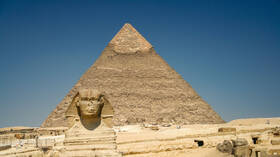For thousands of years, people around the world have celebrated the vernal equinox, which can symbolize not only the beginning of a new era but also soil fertility, agricultural production systems and cultural heritage.
Archaeologists have discovered many ancient sites that coincide with the equinox. However, the purpose of these sites remains a mystery to this day.
The spring equinox occurs on March 20 this year when day and night are equal in the northern hemisphere, and on this day the sun is directly above the equator from the southern hemisphere, which includes Australia, half of Africa, South America and South. America. Part of the Indian subcontinent is towards the Northern Hemisphere, which includes Europe, Asia, North America, and the Arctic.
Archaeologists have discovered that many archaeological sites around the world belonging to different ancient cultures and civilizations show a magical relationship with the sun, which can be seen during the equinox event:
Pyramid of Chichen Itza – Mexico
On the spring equinox, tourists and locals gather at the Chichen Itza pyramid in southern Mexico. When the sun sets in the afternoon, it casts a shadow on the north staircase, which is covered by the snake’s head carved at the bottom of the staircase, giving the impression of a snake slithering down the pyramid.
It probably represents the feathered serpent god Kukulkán or Quetzalcóatl, who descended to earth that day.
Khafre Pyramid and Great Sphinx – Egypt
The Great Sphinx and the Pyramid of Giza are perfectly aligned with the Sun during the equinox event. Swiss archaeologist Herbert Ricke said in the 1960s that the sun seemed to set between the Sphinx’s shoulders.
In fact, the remaining twenty-four columns of the Great Sphinx temple also appear to be equinoxes.
“The shadow of the Sphinx and the shadow of the Pyramid, both symbols of the King, became two unified shapes,” said American archaeologist Mark Lehner at an event for Smithsonian Magazine.
Angkor Wat Temple – Cambodia
On the spring equinox, the sun rises exactly on the central peak of the temple called Angkor Wat in Cambodia.
The building opens onto a 700-year-old canals, temples, shrines, and tombs scattered across 154 square miles of northern Cambodian jungle.
Teotihuacan – Mexico
Every year at the vernal equinox, people gather in the pre-Hispanic region of Teotihuacan, Mexico, dressed in white and red to celebrate the sun.
Like their ancestors, the celebrants climb the pyramid in the field, stretching their arms as they look at the sun as they ask the gods for energy and health.
According to some accounts, the light of the equinox filters into the Quetzalpapálotl Palace at Teotihuacan, built between 450 and 500 AD.
According to reports, light illuminated the celestial figures on the palace walls between 7:15 am and 7:45 am, indicating that the temple was used as a solar observatory.
Loughcrew piles – Ireland
Located in County Meath, Ireland, the Loughcrew mounds, also known as the Witch’s Hills, are one of four major cemeteries built by humans 5,000 years ago.
At the spring and autumn equinoxes, the sun rises just below the entrance to a cave called Cairn T and illuminates the Black Stone, a slab covered with some of Ireland’s finest Neolithic art, according to Irish Heritage.
Antihuatana Stone – Machu Picchu
The sun was a central element of the Inca cult. In the area of Machu Picchu is the Antihuatana, a large square rock that archaeologists perfectly aligned with the sun at the equinoxes to cast no shadow.
Many believe that the stone may have been used as a solar calendar, but some archaeologists say there is not enough evidence to support this.
Manjdra rock temple – Malta
Seven megalithic temples have been found on the Mediterranean islands of Malta and Gozo, classified as World Heritage Sites. These prehistoric structures were built between 4000 BC and 3000 BC.
During the spring and autumn equinoxes, a bright ray of sunlight hits the entrance of the temple and perfectly illuminates the main axis of the building.
Whether the ancients deliberately aligned the temple with the sun is still debated, according to Malta’s National Museums, Conservation Practices and Cultural Heritage Agency, but the orientation is “so systematic that it is likely”.
Source: Business Insider
Source: Arabic RT
